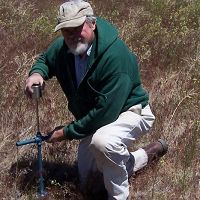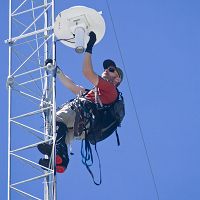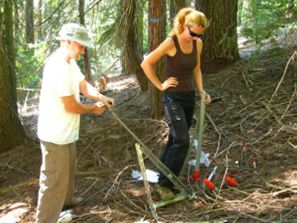Woodward et al. 2013
Nutrient Hot Spots in a Sierra Nevada Forest Soil: Temporal Characteristics and Relations to Microbial Communities
Woodward, C., Johnson, D.W., Meadows, M.W., Miller, W.W., Hynes, M.M., and Robertson, C.M. (2013)
Soil Science
-
Sierra, GRAD STUDENT
-
Sierra, INVESTIGATOR
-
Sierra, STAFF
-
Sierra, COLLABORATOR
Abstract
Matt Meadows (SSCZO Field Manager, SSCZO) and Casandra Woodward (SSCZO/UNR alumna) install the access probes for the resin capsules.
The importance of soil nutrient hot spots is becoming increasingly recognized in terms of both plant nutrition and water quality. Averaging soil nutrient values and eliminating outliers from data sets can obscure important information about the nature and frequency of such hot spots. In this study, soil nutrient hot spots were investigated by sampling forest soils using resin-based methods to capture the effects of leaching and preferential flow followed by destructive O horizon and soil sampling including both nutrient and microbial analyses. Six by six–meter grids (16 grid points at 2-m intervals) were instrumented with UniBest® resin capsules and Western Ag Innovations PRS™ probes in sets of four per grid point at two sites. After the first precipitation event in the fall, two capsules and two probes were removed (referred to as “event samples”), and the remaining two were left in place for the entire winter season and then removed in the following summer (referred to as “season samples”). We hypothesized that hot spots (as indicated by statistical outliers and significant positive skew) would be more prevalent in the event samples than in the season samples because of greater importance of preferential flow during the first event. Data for the resin capsules supported this hypothesis, whereas data for the PRS probes did not. Calcium and Mg2+ values for season samples were significantly greater than those for event samples for both capsules and probes at both sites, as was expected because of the greater exposure to leaching in the season samples. Differences in event and season values for orthophosphate, NO3-, NH4+, and K+ varied, however, with some showing season > event, some no significant difference, and some event > season, suggesting a greater role of biological uptake in spring and perhaps the effect of cation exchange on resins. After the removal of the season resin samples, cores of O horizons and surface mineral soils were taken at each grid point and analyzed for total C and N, water-extractable nutrients, and microbial biomass (the latter in the mineral soil only by phospholipid fatty acid analysis). Correlations with microbial biomass measured via phospholipid fatty acid analysis were inconsistent. In summary, we found no consistent pattern of hot spots with season of sampling or microbial biomass. The seasonality of resin-based measurements suggested that ions of N and P were released mostly during the first precipitation event, whereas the reverse was true for Ca and Mg.
Citation
Woodward, C., Johnson, D.W., Meadows, M.W., Miller, W.W., Hynes, M.M., and Robertson, C.M. (2013): Nutrient Hot Spots in a Sierra Nevada Forest Soil: Temporal Characteristics and Relations to Microbial Communities. Soil Science . DOI: 10.1097/SS.0000000000000023
Explore Further





